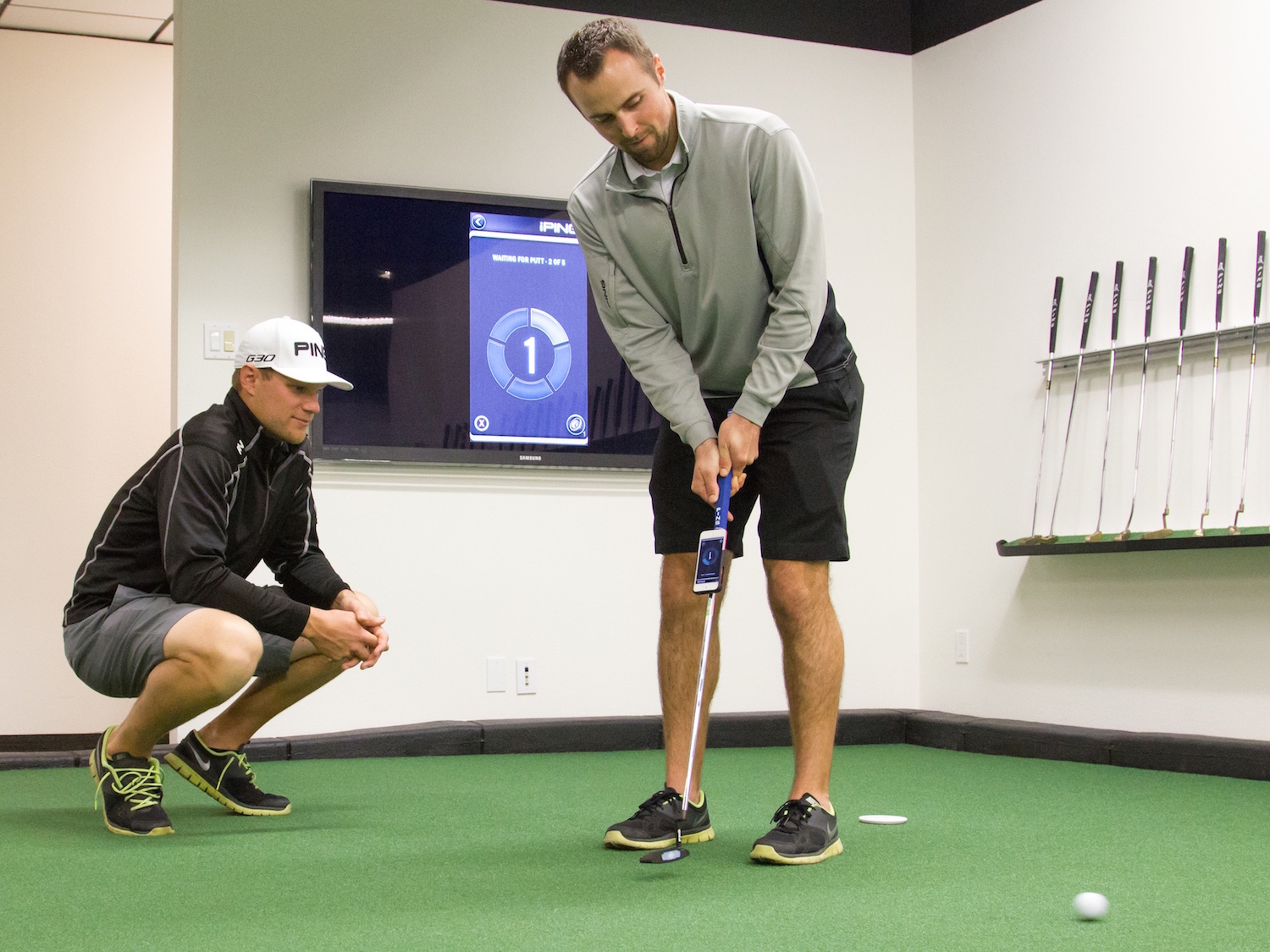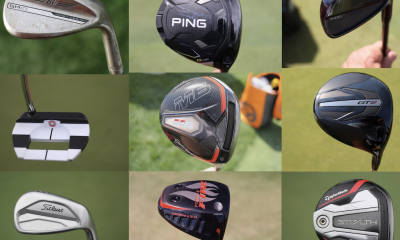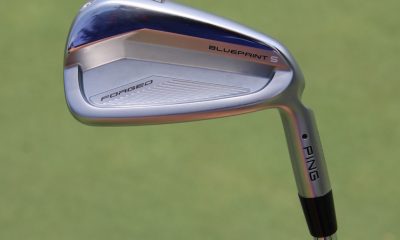Opinion & Analysis
How does the iPING putter app work?

Golf is becoming more and more technological. Well, strictly speaking, the game is the same but the clubs you use and the innovations available to help analyze your swing and your ball flight are advancing fast. Here in the engineering department at Ping, we use simulation and measurement tools today that Karsten Solheim would have dreamed about. It is a great time to be a sports scientist.
iPING’s Beginnings
I remember the day in 2006 when we decided to create our own fitting software using launch-monitor data from new devices on the market such as Vector and TrackMan. I’d spent much of the previous year testing and validating a predictive ball-flight model that could take speeds, angles and spin rates and paint any golf shot into a 3D environment.
Our aim with our nFlight fitting software was to bring fitting into the 21st Century by applying real analysis to launch-monitor data and give meaningful fitting recommendations. We pioneered a few things like optimal shot bands, dispersion ellipses and gapping analysis. A couple of years later we started to talk about applying MEMS technology to measuring a club during a fitting. MEMS (Micro Electro Mechanical Systems) are small, lightweight sensors that measure movement. The devices contain two main types of sensors – three-axis gyroscopes that measure rotational movement (yaw, pitch and roll), and three-axis accelerometers that measure straight-line movement (x, y and z). These sensors are used in many different industries and can track any kind of movement, but they aren’t infallible – they drift over time and there is noise in the data. It’s not realistic to expect the sensors to keep an accurate track of the position of an object for long periods of time, but they are perfect for measuring short-duration movements.
One of our engineers had the idea to take an iPhone 4 and strap it to a putter, using the sensors in the phone itself to measure a putting stroke. I was pretty skeptical about both the sensor quality in the phone and the extra weight affecting the putting stroke, but I was happy to be proven wrong on both counts. The phone is placed close to the grip and doesn’t affect the swing weight of the putter much at all. The extra weight is easily detectible by a golfer but not distracting, even to our tour players. We also verified that the device doesn’t change the putting stroke and gives us accurate enough readings, all for the cost of a plastic cradle.
iPING reliably captures the closing angle (stroke type), impact angle, tempo, shaft lean and lie angle. It is important to note that iPING has no way to know where the hole is, which is typical for any MEMS device. As a result, you will see that many of the attributes we track are internal to the stroke, say from address to impact. We can’t tell you whether the putter face was open or closed to the target because we can’t know where the target is, however, the sensor does know which way is down by measuring gravity and this is how we measure a real shaft lean and lie angle.
Consistency is Key
So, what benefit do we get from tracking a putting stroke? Well, primarily we want to measure consistency. All our research with elite players and tour players shows that even though the motion of their putting strokes varied, the single thing they all have in common is a high degree of consistency when compared to higher-handicap players. Based on our experiments, it doesn’t seem to matter how much arc is in your stroke, if you align at the hole or consistently left or right, or if your tempo is quick or slow, so long as there is consistency in the stroke. The key was that we established a relationship between the consistency (standard deviation, the statistical term for it) of any given attribute when repeated over five putts and a player’s handicap.
Figure 1 (below) shows this relationship for closing angle. We put this together to create a score for a five-putt session in iPING that rates your consistency over five attributes against players of a certain handicap. So if your score for a session is 9.0, you putted like a typical 9-handicap player. Using this score gives players an instant understanding of what is good and bad, and allows someone to quantify whether one session is significantly better than another. For example, you can use this in practice to measure technique changes. Just try using iPING outside in the wind and then inside on a flat green to see what impact that has on your consistency.
iPING Data
When we use iPING in fitting we can take stroke type, impact angle, tempo, shaft lean, and lie angle readings to dial in the best putter for your stroke. Figure 2 shows how we would take each of the five main attributes and recommend a putter that will improve a player’s consistency. This is based on a lot of experiments in the putter lab.
There are a few things that stand out from the nearly 10 million putts registered on iPING.
- There is no such thing as Tour tempo. Tour players have an average tempo of close to 2.0 on iPING, but there are some as low as 1.4 and some over 2.5, all with good putting numbers on the tour.
- Beginner golfers often have a very flat lie angle and upwards of 10 degrees of arc in the stroke. We really don’t ever see this among elite golfers, which would suggest it is detrimental to producing good results. The average tour player has about 5 degrees of arc in his or her putting stroke (on a putt from 10 feet).
- The general public tends to add a little loft with the hands on average; elite and tour players tend to de-loft the putter a little.
- Even among the very best players, very few have the putter face totally square to the hole at address. Some good tour players consistently line up 4 or 5 degrees to one side of the hole. Since we have no evidence that it’s important to consistency, it’s not something we try to “fix.” If putts are consistently missed left or right, then a choice of alignment features and/or hang angle can help that.
The ability to acquire and analyze large sets of information from tools like iPING has certainly helped us answer some big questions about putter design and fitting, and hopefully help a few people make some more putts.
Opinion & Analysis
The 2 primary challenges golf equipment companies face

As the editor-in-chief of this website and an observer of the GolfWRX forums and other online golf equipment discourse for over a decade, I’m pretty well attuned to the grunts and grumbles of a significant portion of the golf equipment purchasing spectrum. And before you accuse me of lording above all in some digital ivory tower, I’d like to offer that I worked at golf courses (public and private) for years prior to picking up my pen, so I’m well-versed in the non-degenerate golf equipment consumers out there. I touched (green)grass (retail)!
Complaints about the ills of and related to the OEMs usually follow some version of: Product cycles are too short for real innovation, tour equipment isn’t the same as retail (which is largely not true, by the way), too much is invested in marketing and not enough in R&D, top staffer X hasn’t even put the new driver in play, so it’s obviously not superior to the previous generation, prices are too high, and on and on.
Without digging into the merits of any of these claims, which I believe are mostly red herrings, I’d like to bring into view of our rangefinder what I believe to be the two primary difficulties golf equipment companies face.
One: As Terry Koehler, back when he was the CEO of Ben Hogan, told me at the time of the Ft Worth irons launch, if you can’t regularly hit the golf ball in a coin-sized area in the middle of the face, there’s not a ton that iron technology can do for you. Now, this is less true now with respect to irons than when he said it, and is less and less true by degrees as the clubs get larger (utilities, fairways, hybrids, drivers), but there remains a great deal of golf equipment truth in that statement. Think about it — which is to say, in TL;DR fashion, get lessons from a qualified instructor who will teach you about the fundamentals of repeatable impact and how the golf swing works, not just offer band-aid fixes. If you can’t repeatably deliver the golf club to the golf ball in something resembling the manner it was designed for, how can you expect to be getting the most out of the club — put another way, the maximum value from your investment?
Similarly, game improvement equipment can only improve your game if you game it. In other words, get fit for the clubs you ought to be playing rather than filling the bag with the ones you wish you could hit or used to be able to hit. Of course, don’t do this if you don’t care about performance and just want to hit a forged blade while playing off an 18 handicap. That’s absolutely fine. There were plenty of members in clubs back in the day playing Hogan Apex or Mizuno MP-32 irons who had no business doing so from a ballstriking standpoint, but they enjoyed their look, feel, and complementary qualities to their Gatsby hats and cashmere sweaters. Do what brings you a measure of joy in this maddening game.
Now, the second issue. This is not a plea for non-conforming equipment; rather, it is a statement of fact. USGA/R&A limits on every facet of golf equipment are detrimental to golf equipment manufacturers. Sure, you know this, but do you think about it as it applies to almost every element of equipment? A 500cc driver would be inherently more forgiving than a 460cc, as one with a COR measurement in excess of 0.83. 50-inch shafts. Box grooves. And on and on.
Would fewer regulations be objectively bad for the game? Would this erode its soul? Fortunately, that’s beside the point of this exercise, which is merely to point out the facts. The fact, in this case, is that equipment restrictions and regulations are the slaughterbench of an abundance of innovation in the golf equipment space. Is this for the best? Well, now I’ve asked the question twice and might as well give a partial response, I guess my answer to that would be, “It depends on what type of golf you’re playing and who you’re playing it with.”
For my part, I don’t mind embarrassing myself with vintage blades and persimmons chasing after the quasi-spiritual elevation of a well-struck shot, but that’s just me. Plenty of folks don’t give a damn if their grooves are conforming. Plenty of folks think the folks in Liberty Corner ought to add a prison to the museum for such offences. And those are just a few of the considerations for the amateur game — which doesn’t get inside the gallery ropes of the pro game…
Different strokes in the game of golf, in my humble opinion.
Anyway, I believe equipment company engineers are genuinely trying to build better equipment year over year. The marketing departments are trying to find ways to make this equipment appeal to the broadest segment of the golf market possible. All of this against (1) the backdrop of — at least for now — firm product cycles. And golfers who, with their ~15 average handicap (men), for the most part, are not striping the golf ball like Tiger in his prime and seem to have less and less time year over year to practice and improve. (2) Regulations that massively restrict what they’re able to do…
That’s the landscape as I see it and the real headwinds for golf equipment companies. No doubt, there’s more I haven’t considered, but I think the previous is a better — and better faith — point of departure when formulating any serious commentary on the golf equipment world than some of the more cynical and conspiratorial takes I hear.
Agree? Disagree? Think I’m worthy of an Adam Hadwin-esque security guard tackle? Let me know in the comments.
@golfoncbs The infamous Adam Hadwin tackle ? #golf #fyp #canada #pgatour #adamhadwin ? Ghibli-style nostalgic waltz – MaSssuguMusic
Podcasts
Fore Love of Golf: Introducing a new club concept

Episode #16 brings us Cliff McKinney. Cliff is the founder of Old Charlie Golf Club, a new club, and concept, to be built in the Florida panhandle. The model is quite interesting and aims to make great, private golf more affordable. We hope you enjoy the show!
Opinion & Analysis
On Scottie Scheffler wondering ‘What’s the point of winning?’

Last week, I came across a reel from BBC Sport on Instagram featuring Scottie Scheffler speaking to the media ahead of The Open at Royal Portrush. In it, he shared that he often wonders what the point is of wanting to win tournaments so badly — especially when he knows, deep down, that it doesn’t lead to a truly fulfilling life.
View this post on Instagram
“Is it great to be able to win tournaments and to accomplish the things I have in the game of golf? Yeah, it brings tears to my eyes just to think about it because I’ve literally worked my entire life to be good at this sport,” Scheffler said. “To have that kind of sense of accomplishment, I think, is a pretty cool feeling. To get to live out your dreams is very special, but at the end of the day, I’m not out here to inspire the next generation of golfers. I’m not out here to inspire someone to be the best player in the world, because what’s the point?”
Ironically — or perhaps perfectly — he went on to win the claret jug.
That question — what’s the point of winning? — cuts straight to the heart of the human journey.
As someone who’s spent over two decades in the trenches of professional golf, and in deep study of the mental, emotional, and spiritual dimensions of the game, I see Scottie’s inner conflict as a sign of soul evolution in motion.
I came to golf late. I wasn’t a junior standout or college All-American. At 27, I left a steady corporate job to see if I could be on the PGA Tour starting as a 14-handicap, average-length hitter. Over the years, my journey has been defined less by trophies and more by the relentless effort to navigate the deeply inequitable and gated system of professional golf — an effort that ultimately turned inward and helped me evolve as both a golfer and a person.
One perspective that helped me make sense of this inner dissonance around competition and our culture’s tendency to overvalue winning is the idea of soul evolution.
The University of Virginia’s Division of Perceptual Studies has done extensive research on reincarnation, and Netflix’s Surviving Death (Episode 6) explores the topic, too. Whether you take it literally or metaphorically, the idea that we’re on a long arc of growth — from beginner to sage elder — offers a profound perspective.
If you accept the premise literally, then terms like “young soul” and “old soul” start to hold meaning. However, even if we set the word “soul” aside, it’s easy to see that different levels of life experience produce different worldviews.
Newer souls — or people in earlier stages of their development — may be curious and kind but still lack discernment or depth. There is a naivety, and they don’t yet question as deeply, tending to see things in black and white, partly because certainty feels safer than confronting the unknown.
As we gain more experience, we begin to experiment. We test limits. We chase extreme external goals — sometimes at the expense of health, relationships, or inner peace — still operating from hunger, ambition, and the fragility of the ego.
It’s a necessary stage, but often a turbulent and unfulfilling one.
David Duval fell off the map after reaching World No. 1. Bubba Watson had his own “Is this it?” moment with his caddie, Ted Scott, after winning the Masters.
In Aaron Rodgers: Enigma, reflecting on his 2011 Super Bowl win, Rodgers said:
“Now I’ve accomplished the only thing that I really, really wanted to do in my life. Now what? I was like, ‘Did I aim at the wrong thing? Did I spend too much time thinking about stuff that ultimately doesn’t give you true happiness?’”
Jim Carrey once said, “I think everybody should get rich and famous and do everything they ever dreamed of so they can see that it’s not the answer.”
Eventually, though, something shifts.
We begin to see in shades of gray. Winning, dominating, accumulating—these pursuits lose their shine. The rewards feel more fleeting. Living in a constant state of fight-or-flight makes us feel alive, yes, but not happy and joyful.
Compassion begins to replace ambition. Love, presence, and gratitude become more fulfilling than status, profits, or trophies. We crave balance over burnout. Collaboration over competition. Meaning over metrics.
Interestingly, if we zoom out, we can apply this same model to nations and cultures. Countries, like people, have a collective “soul stage” made up of the individuals within them.
Take the United States, for example. I’d place it as a mid-level soul: highly competitive and deeply driven, but still learning emotional maturity. Still uncomfortable with nuance. Still believing that more is always better. Despite its global wins, the U.S. currently ranks just 23rd in happiness (as of 2025). You might liken it to a gifted teenager—bold, eager, and ambitious, but angsty and still figuring out how to live well and in balance. As much as a parent wants to protect their child, sometimes the child has to make their own mistakes to truly grow.
So when Scottie Scheffler wonders what the point of winning is, I don’t see someone losing strength.
I see someone evolving.
He’s beginning to look beyond the leaderboard. Beyond metrics of success that carry a lower vibration. And yet, in a poetic twist, Scheffler did go on to win The Open. But that only reinforces the point: even at the pinnacle, the question remains. And if more of us in the golf and sports world — and in U.S. culture at large — started asking similar questions, we might discover that the more meaningful trophy isn’t about accumulating or beating others at all costs.
It’s about awakening and evolving to something more than winning could ever promise.
























Anna Simon
Nov 4, 2015 at 5:10 pm
Hi Paul,
I am currently working with a company that is building a new product that helps golfers improve and analyze their golf swing, taking a multi-sensor approach to the swing analyzers products on the market. The product’s Kickstarter will be launching later this month. Would you like us to get in touch with you to test the product? If so, please send me your email to anna@duotrac.com.
Many Thanks,
Anna Simon
Ian Jones
Feb 10, 2015 at 8:23 pm
Yes – bought it for the galaxy S3 (even got the S3 because Ping did this alleged great app)….. AND….of course it didnt work. very disappointed. Surprisingly Ping customer service didnt seem to want to know when I called. Was there a recall since it didnt work ? Now have a $30 piece of plastic sat in a box, keeping company with old yardage books.
killerbgolfer
Feb 8, 2015 at 10:27 pm
Love what you do PING. Consistently the most progressive company with outstanding products and service.
Mike
Feb 7, 2015 at 3:05 pm
Do Ping have plans to release an iPhone 6 cradle? I’m lost without one.
Rene Realme
Feb 6, 2015 at 4:27 pm
Galaxy S4 cradle please!
Mark
Feb 6, 2015 at 3:27 pm
So any thoughts on providing this app for Android users who are 50% of the smartphone market??????
Paul Wood
Feb 6, 2015 at 6:50 pm
Unfortunately, the android platform makes this really tough. There’s so much variation in phones and sensors. We looked at it seriously and even briefly released a version for the Galaxy S3 but even just that 1 model had something like 10 different hardware versions, so it made it almost impossible to ensure functionality and accuracy. Maybe we’ll have to look at something where we use a MEMS device instead of the phone to link up to iPing as a solution for Android users. We’ll keep looking!
Mike Olsen
Feb 6, 2015 at 12:53 pm
Paul,
Just curious as to how the iPing data stands up to the SAM Puttlab output…both in terms of accuracy and consistency of the data? Thanks
Paul Wood
Feb 6, 2015 at 6:54 pm
We have a SAM Puttlab in our lab and we used both the SAM and high speed video data to check the accuracy and consistency of our data. I myself was surprised how good the phone’s sensors did in our testing. Clearly there are quite a few aspects of the putt that the SAM measures that we don’t but the SAM is quite a big investment for someone.
John Grossi
Feb 6, 2015 at 5:42 am
Paul, Thanks for this explanation on Ping’s putter app. However, I am interested in Ping’s NFlight(sp) device. Would you consider an article on it? These MEMS devices are very interesting on how they relate to the golf swing.
Paul Wood
Feb 6, 2015 at 11:00 am
I’d certainly be very happy to do an article on nFlight. I might try to cover a couple of other topics relating to club technology or golf physics first but I’ll try to come back to fitting tools again. I’m really interested in MEMS technology personally – it would be a pleasure to write more on the subject.
mike
Feb 5, 2015 at 5:16 pm
Great product. It is very consistent and helped me to slow down my putts.
Golfraven
Feb 5, 2015 at 2:40 pm
The cradle still fits the iphone 5 but I am not sure I tested it never iphone 6 model. reminds me to take it out of my golf bag locker and use it again. Saddly the app is lacking better stats analysis and is not showing dates when you did the putting therefor difficult to compare unless you write dates in your notepad. i agree that putting with the phone does not affect the stroke itself but I feel the weight of it and also the impact sound is slighly different. however it is great tool which provides important data on stroke type, tempo, shaft lean, lie angle etc.. I would say biggest feedback is weather your stroke is consistent, independent of how you roll the ball. I am close to +PHcp and it helps me to focus when practicing. All pros are around +4 and comparing against those is good indication what your putting is lacking. So as with anything in golf, consistency is key
MS
Feb 5, 2015 at 4:38 pm
Golfraven – On the “Measure” screen, you can change the name of each session. Look at the picture above where it says “Session 17” – if you tape on the name (not the drop down arrow), it will bring up the keyboard and you can change the session to a date or whatever you would to call it.
The best way to utilize this is on a day when you are putting well. Take a quick session and save it by date, “good putting day”, etc so you know where to find it. Then you will have it stored what your stats are when you are rolling it well. Helps you go back and compare when you have an off day and can help figure out why.
Golfraven
Feb 5, 2015 at 5:48 pm
Thanks for the hint, much appreciated. been using this now for last 2-3 years and never figured it out.
bph
Feb 5, 2015 at 1:41 pm
How does it work? The answer is it doesn’t. Be careful before buying this. The app has been broken for at least a year (on iPhone at least), leaving me with a useless $30 piece of plastic.
MS
Feb 5, 2015 at 4:39 pm
Have you tried deleting the app and reinstalling?
Paul Wood
Feb 5, 2015 at 6:29 pm
I’m really sorry to hear your app is not working correctly. Our application support would be happy to help you get that figured out. Their number is 855-687-5700 or appsupport@ping.com We do our best to make sure it works for as many people as possible, but I’m not going to lie, making apps is hard when hardware and software are progressing at such a fast pace.
Ed
Feb 5, 2015 at 1:08 pm
I have one for my iphone4, which i don’t have anymore..
Will ping discount if i get one for iphone 5 or 6?
Double Mocha Man
Feb 5, 2015 at 1:05 pm
The app works great. But finding a cradle that fits my phone is problematic. So I’ve used duct tape in the past. One more use for duct tape…
Tom Stickney
Feb 5, 2015 at 10:29 am
It’s a great tool for sure.